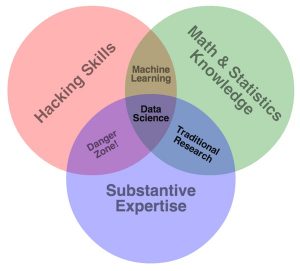During a five-week IBM training program, I learned a few things about how to sell data science models that I’d like to share it with you. The program was explicitly designed to educate and familiarize IBM’s business partners on how to expand relationships with clients; an introduction to emerging tools; and a glimpse into IBM’s future so that business partners strategically leverage clients in the competitive AI movement.
You’ve probably seen the Venn diagram with skills required to be a data scientist such as hacking skills, math & statistics, and substantive expertise. The combination of these skills are what makes a good data scientist. However, you can be a unicorn and possess all the skills and develop a phenomenal model, but the majority of your success will depend on if your model goes to production or project sponsor/ client approves it. The ability to sell your model is as crucial as the aforementioned skills.
In my experience as a data scientist, we are good at developing models, but not so good at selling these models. Sometimes, when we are presenting our models we encounter challenges: code does not run, the information is too technical, not enough material is covered, data is not available (in my experience), you can’t find your latest model, or you got off track in presenting your creation. As Murphy’s law states, anything that can go wrong, will go wrong.
So, I decided to compose a list of points on how to sell/ productionize your model.
Quick Tips for Selling Your Data Science Model
1. Know your audience
Either you are working with a data scientist, a C-level executive, or a manager. You should know who are the stakeholders and design your presentation accordingly. For example, whenever you are presenting to non-technical personnel you do not need to go into coding part of the model. If you are showing a Jupyter notebook, it is a good idea just to go through the output and hide the code, because this will only confuse and create more questions. If you have a data scientist/ technical person in the room, schedule a different meeting to go over the technical aspects of your model.
2. Engage your audience
Engaging your audience will help them stay focused on a subject through the iterative approach of asking questions throughout your presentation. For example, if you are discussing your model try to trigger their limbic system (the part of the brain concerned with instinct and mood) by asking a question about their company, or information related to the model you created.
3. Prepare a story
Storytelling is an essential part of the modeling process. I like to call this process “wow them then how them.” This excellent idea is to show your audience the results of your model and then tell them how you got there. Think of it in a way as a magic trick. First you pull the rabbit out of a hat and then you tell them how you did it. The idea is to keep your audience focused on the process of you going through the model.
4. Prepare for unexpected
Whenever you present your model within the notebook, always have PowerPoint presentation available with images from that notebook. If something doesn’t go according to plan, you will have PowerPoint as a backup.
5. Bigger than you
This tip may not apply to you; however, it is imperative. Whenever you’re presenting a model make sure you use names that have credibility, because credibility creates a relationship. In your presentation try to use the names of the tools/ platforms that are well-known. This will help you build trust with key individuals.
6. Demand action
Start driving your discussion toward action as you present your model. Drive management to choose the next step. Don’t assume they will get back to you, because it’s often difficult for management to see the value immediately or they’re busy. So, use your presentation and model to compel them to act.
These are my 6 points of how to sell/ productize your model. As data scientists, we all have different skills and abilities. So this list of points may not work as well for you as it worked for me. Still, I would love to hear your feedback and suggestions on possibilities or methods you encountered with presenting your model. Leave your comments below.


